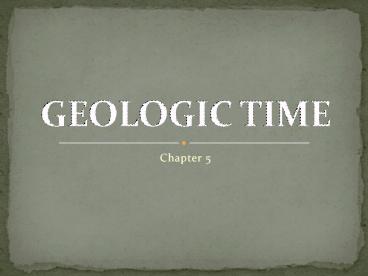GEOLOGIC TIME - PowerPoint PPT Presentation
1 / 15
Title:
GEOLOGIC TIME
Description:
... Paleozoic, Mesozoic and Cenozoic Period ... major subdivisions of animal history Sometimes called the Age of Mammals Tertiary Period Quaternary Period ... – PowerPoint PPT presentation
Number of Views:262
Avg rating:3.0/5.0
Title: GEOLOGIC TIME
1
GEOLOGIC TIME
- Chapter 5
2
PrecambrianEon
- 4.5 billion years ago, the Earth was born.
- Consider that the Earth formed, life arose
- - the first tectonic plates arose and began to
move - - eukaryotic cells evolved
- - the atmosphere became enriched in oxygen
and - - just before the end of the Precambrian,
complex multicellular organisms, including the
first animals, evolved
3
Earth is constantly changing
- 1700 James Hutton began to question about
changes of Earth he came up the hypothesis about
changing Earth over time. - UNIFORMITARIANISM Huttons theory
- Earth is an always-changing place
- The same forces of change at work today were at
work in the past.
4
Alfred Wegener
- German scientist that proposed a hypothesis about
continental drift in 1912. - He called the landmass Pangaea
- His ideas led to the theory of Plate Tectonics
- Plate tectonics states that Earths lithosphere
is made up of huge plates that move over the
surface of Earth
5
Geologic Time Scale
- It divides Earths history into intervals of time
defined by major events or changes on Earth - Divisions of Geologic Time
- Eon the largest time, Earth has 4 eons
- Era Eons are divided into eras Paleozoic,
Mesozoic and Cenozoic - Period - Each era is subdivided into a number of
periods - Epoch The periods of the Cenozoic, are further
divided into epochs
6
Precambrian Time
- Make up almost 90 percent of Earths history
- Division of Precambrian Time
- Hadean Eon
- Archean Eon
- Proterozoic Eon
7
Hadean time
- 4.5 to 3.8 billion years ago
- the Solar System was forming
8
Archaean
- 3.8 to 2.5 billion years ago
- With a reducing atmosphere of methane, ammonia,
and other gases - The Earth's crust cooled enough that rocks and
continental plates began to form.
9
Proterozoic Eon
- 2.5 billion to 543 million years ago
- Stable continents first appeared and began to
accrete, a long process taking about a billion
years - In the Middle Proterozoic comes the first
evidence of oxygen build-up in the atmosphere
10
Phanerozoic Eon
- The majority of microscopic organisms, algal,
fungal, plant and animal lived. - approximately 544 million years ago
- Division
- Paleozoic Era
- Mesozoic Era
- Cenozoic Era
11
Paleozoic Era
- 544 to 248 Million Years Ago
- Also known as the Ancient Life
- multicellular animals underwent a dramatic
explosion in diversity - At the other end of the Paleozoic, the largest
mass extinction in history wiped out
approximately 90 of all marine animal species - During the Paleozoic there were six major
continental land masses each of these consisted
of different parts of the modern continents.
12
Division of Paleozoic Era
- Cambrian Period
- Ordovician Period
- Silurian Period
- Devonian Period
- Carboniferous Period
- Permian Period
13
Mesozoic Era
- 248 to 65 Million Years Ago
- Whose name means middle life
- The Mesozoic is divided into three time periods
- the Triassic (245-208 mya)
- the Jurassic (208-146 mya)
- and the Cretaceous (146-65 mya).
14
Cenozoic Era
- 65 Million Years to the Present
- The name means recent life
- The Cenozoic is the most recent of the three
major subdivisions of animal history - Sometimes called the Age of Mammals
15
Division
- Tertiary Period
- Quaternary Period stretches from 2 mya to the
present - Most of this period has been a series of ice
ages, with much of the planet covered in thick
sheet of ice - Fossils of the modern humans are also from this
period. They are about 100,000 years old.































